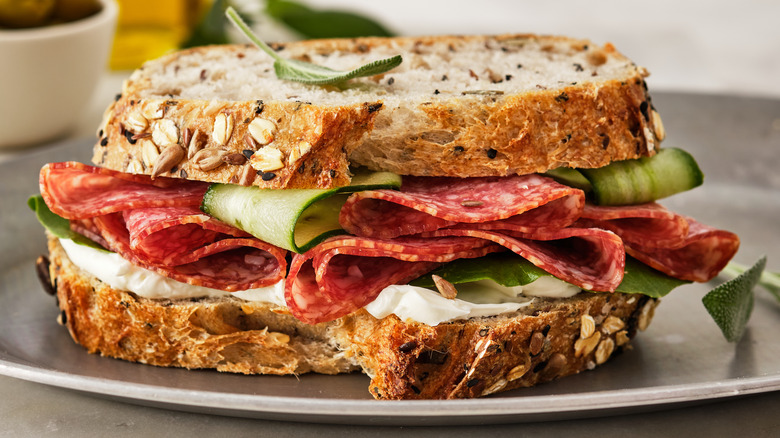The Clever Butter Trick To Prevent Soggy Freezer Sandwiches
Meal prep has been all the rage for a while now. Taking a day to plan and prepare your meals for the week can buy you more time, and mean less food going to waste. However, meal planning can become stale because it often depends on eating leftovers, or preparing big batches of food that are freezer friendly. Traditional lunch staples, like sandwiches, often get skipped over when it comes to advance planning because they don't hold up well in the fridge over time.
We've all unwrapped a sandwich that is too soggy for its own good and so people stick to other choices when making lunch for the week. The reality is sandwiches can be made in advance just as easily, but they require a little extra care and a foolproof tip to keep their quality up until you're ready to eat them. Sandwiches can easily be stored in the freezer for freshness as long as you protect the bread with a layer of butter to keep moisture out.
It's all in the butter
The concern with putting sandwiches in the freezer is that moisture from your filling is going to make the bread soggy. Things like tomato and cucumbers have a lot of moisture, and when paired with the sandwiches defrosting, it's traditionally a recipe for a wet and sad sandwich. However, a layer of butter or mayo can prevent that sogginess by creating a barrier between the bread and the meat of the sandwich.
To get the absolute most out of this trick, the toaster can lend a hand by removing more moisture. Place your bread in the toaster and heat it till it's just getting crisp on the outside — no more than a few minutes. Next, let the bread cool completely before applying your layer of butter. Since the goal is to minimize moisture, you want a healthy layer of butter on both slices of bread. Any uncovered bread could get soggy before you know it.
More tips for storing your sandwich in the freezer
Using a layer of spread to stop moisture is a great trick, but it's not the only thing that can improve your pre-made sandwiches. It's important to think about what you are putting in your sandwiches. If you're using tomatoes, it's worth it to scoop out the seeds and only use the flesh; that will give you all the flavor without all the extra moisture. Similarly, opting for a seedless cucumber gives your sandwich some crunch, but lower water content.
Once your sandwiches are assembled, it's time to package them for the stay in the freezer. First, wrap your sandwiches tightly in plastic wrap or foil (parchment paper works, too). Then, put your sandwiches in a heavy-duty freezer bag before putting them in the freezer.
If you're storing a variety of sandwiches, it's handy to label the wrappers with a permanent marker, or use separate labeled bags to indicate which type of sandwich is which. Soggy sandwiches are off the menu once you start using this trick, and your workday lunches will thank you for it.


